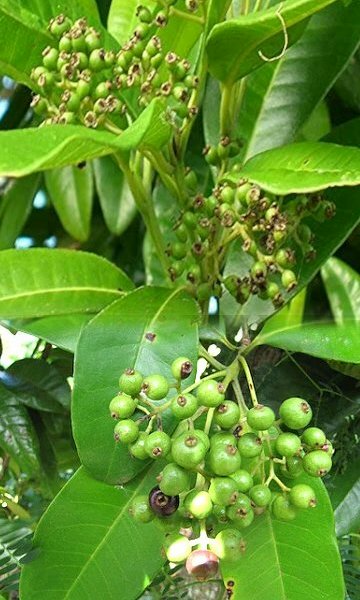
|
|
Allspice ( Pimenta dioica).
Leaves and fruits.
|
Allspice - Pimenta dioica
Allspice, (Pimenta dioica), tropical evergreen tree of the myrtle family (Myrtaceae) and its berries, the source of a highly aromatic spice. The plant is native to the West Indies and Central America. Allspice was so named because the flavour of the dried berry resembles a combination of cloves, cinnamon, and nutmeg.
Allspice, also known as Jamaica pepper, myrtle pepper, pimenta, or pimento, is the dried unripe berry of Pimenta
dioica.
Pimenta dioica, is a small evergreen midcanopy tree that typically grows 7 - 10 metres tall but occasionally reaches 20 metres. The bole can be up to 30cm in diameter. Allspice can be a small, scrubby tree, quite similar to the bay laurel in size and form. It can also be a tall canopy tree, sometimes grown to provide shade for coffee trees planted underneath
it.
Leaves (7-15 cm long) are oblong, leathery and aromatic. Creamy white flowers in panicles (pyramidal cymes) bloom from the upper leaf axils in summer. Female flowers give way to small green fruits which mature to reddish-brown.
Genus name comes from the Spanish word pimienta meaning "pepper", in reference to the similar appearance of the fruits of this species to those of the genus Piper which includes black pepper.
Specific epithet means dioecious, or having separate male and female plants.
The tree was used as a spice in the Caribbean before the arrival of the Europeans. Early Spanish explorers, mistaking it for a type of pepper, called it pimenta, hence its botanical name and some of its common names. The first record of its import to Europe is from 1601. The name allspice was coined as early as 1621 by the English, who valued it as a spice that combined the flavours of cinnamon, nutmeg, and clove. Contrary to common misconception, it is not a mixture of spices.
Christopher Columbus became aware of allspice on his second New World voyage, and the plant soon became part of European
diets. At the time, it was found only on the island of Jamaica, where birds readily spread the seeds. To protect the pimenta trade, Jamaican growers guarded against export of the plant.
Allspice has become a popular spice in many areas of the world and is now often cultivated in the American tropics, especially in Jamaica, and occasionally elsewhere.
Allspice is the dried fruit of the Pimenta dioica plant. The fruits are picked when green and unripe, and are traditionally dried in the sun. When dry, they are brown and resemble large, smooth peppercorns.
The dried fruits are used as a flavouring in a wide range of foods. They are said to combine the aroma and flavour of nutmeg, cloves and cinnamon. They are used in pickles, sauces, ketchup, soups, ice cream etc. They are an important component of pimento dram, a Jamaican drink made with rum, and of liqueurs like Benedictine and Chartreuse.
Fresh leaves used as a condiment or steeped to make a tea.
They are similar in texture to bay leaves and similarly used in cooking. Leaves and wood are often used for smoking meats where allspice is a local crop.
An essential oil obtained from the leaves is used to flavour a wide range of foods, including baked goods, candy and chewing gum.
Allspice is one of the most important ingredients of Jamaican cuisine. Under the name pimento, it is used in Jamaican jerk seasoning, and traditionally its wood was used to smoke jerk in Jamaica. In the West Indies, an allspice liqueur is produced under the name "pimento dram". In Mexican cuisine, it is used in many dishes, where it is known as pimienta gorda.
Allspice is also indispensable in Middle Eastern cuisine, particularly in the Levant, where it is used to flavour a variety of stews and meat dishes, as well as tomato sauce. In Arab cuisine, for example, many main dishes use allspice as the only spice.
In Northern European and North American cooking, it is an ingredient in commercial sausage preparations and curry powders, and in pickling.
In the United States, it is used mostly in desserts, but it is also responsible for giving Cincinnati-style chili its distinctive aroma and flavor. Allspice is commonly used in Great Britain, and appears in many dishes. In Portugal, whole allspice is used heavily in traditional stews cooked in large terracotta pots in the Azores islands.
In the United Kingdom it is a dominant flavour in the condiment Brown sauce.
Allspice is also one of the most used spices in Polish cuisine (used in most dishes, soups and stews) and is commonly known under the name English herb (Polish: ziele angielskie) since Britain was its major exporter.
Allspice is an important part of Swedish and Finnish cuisine. Whole allspice is used to flavour soups as well as stews such as Karelian hot pot. Ground allspice is also used in various dishes, such as minced meat sauces, Swedish meatballs, lutefisk and different cakes.
In medicinal use Allspice berries contain about 4% essential oils (of which about 80% is eugenol), proteins, lipids, the vitamins A, B1, B2 and C, plus minerals. It is a pungent, warming, aromatic herb with a clove-like aroma. It improves the digestion, has a tonic effect upon the nervous system and is locally antiseptic and anaesthetic.
It is used internally in the treatment of indigestion, wind, diarrhoea and nervous exhaustion. Allspice is often combined with herbs that have a tonic or laxative effect.
Externally, it is used to treat chest infections, muscular aches and pains.
The essential oil is carminative and antioxidant. The essential oil is used to ease the pain of toothache.
The powdered berries are added to other medicines in order to disguise unpleasant flavours.
An essential oil obtained from the leaves, called pimento leaf oil, is used in perfumery, especially in oriental fragrances and after-shave lotions.
Source:
https://en.wikipedia.org/wiki/Allspice
http://www.missouribotanicalgarden.org/plantfinder/
PlantFinderDetails.aspx?taxonid=282860
https://tropical.theferns.info/viewtropical.php?id=Pimenta+dioica
